- Inflation and rate hikes weighed down Asia equities in 2022, but outperforming emerging markets like India and Southeast Asia offered highly sought-after diversification opportunities.
- We believe there is minimal further downside in China under current conditions and significant upside with any further easing of pandemic controls.
- In India, we see opportunities in large cap financial and auto companies that capitalize on pent-up demand; initial public offerings (IPOs) of companies with attractive business models and pricing; and companies that benefit from declining global commodity prices.
- In our view, patience and careful stock selection are key to withstanding market contractions and finding long-term winners in turbulent markets.
Asian equities struggled to swim against the tide for most of 2022, weighed down by the risk-off sentiment globally amid inflation and rate hikes. While returns year to date have been negative for the Asia ex Japan region as whole, India and the Association of Southeast Asian Nations (ASEAN) market have outperformed the global equity benchmark.
MSCI India and ASEAN Have Outperformed
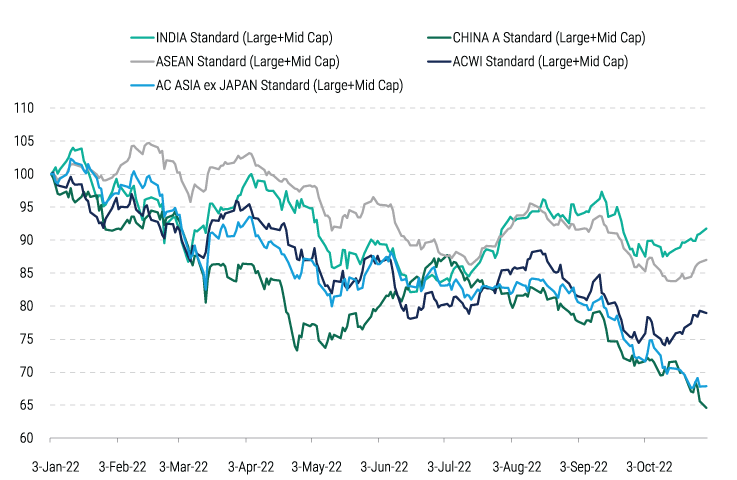
Uniquely to Asia, Covid-19 remains a major market factor even as its influence on investments has shifted to the sidelines in other regions. This also partly explains the divergence in performance of Asia ex Japan’s two largest economies, China and India. In a slowing global economy with many moving parts to contend with, the question on Asia equity investors’ minds is how and where to find diversification and long-term growth in an environment of instability and inflation. We believe patience pays off in the long run, and while the dark economic clouds are not lifting anytime soon for the global economy, there are always pockets of opportunity in Asia to uncover.
India: the post-pandemic investment darling
In a year marked by an unwelcome positive correlation between developed market equities and bonds, India equities offered a rare diversification opportunity for global investors in 2022. The Indian economy has been growing steadily, drawing strength from its macroeconomic fundamentals and buffers. Supported by time-bound and targeted monetary, regulatory, and fiscal policies, the economic recovery against a volatile global backdrop has been broad-based and resilient. MSCI India outperformed the MSCI Emerging Markets Index and the ACWI by double-digit percentage points, recording positive returns while the two other indexes remained in negative territory.1 Domestic institutional investors’ flows buffered foreign investor selling, lending stability and liquidity to the market.
Domestic Investors Stabilize Institutional Equity Flows
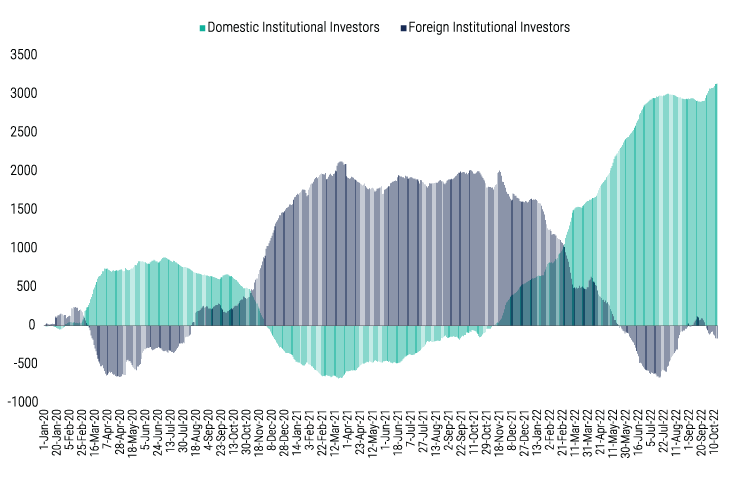
We expect corporate earnings in India to remain generally strong into the beginning of calendar year 2023. Balance sheets of companies are robust, with low debt-to-equity levels, while bank balance sheets have also seen a clean-up of past bad loans, leading to one of the healthiest net nonperforming asset (NPA) ratios in recent history. A strong banking sector is now able to provide businesses required credit at a healthy rate to support their growth.
Corporate Leverage Is Falling
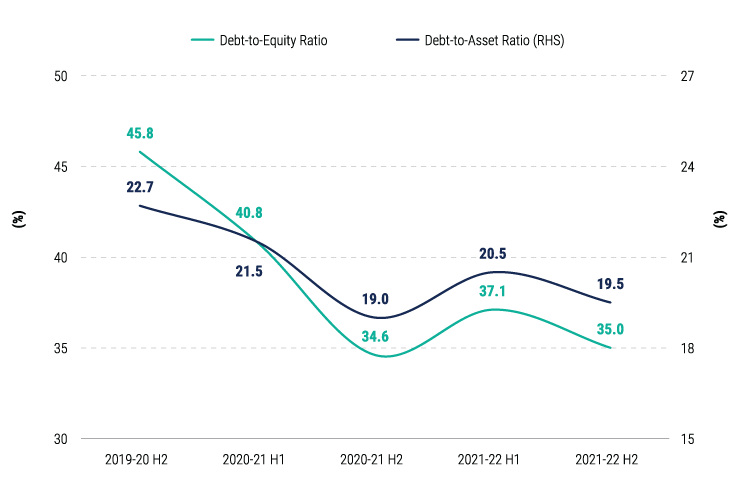
Consequently, Banks’ Asset Quality Is Improving
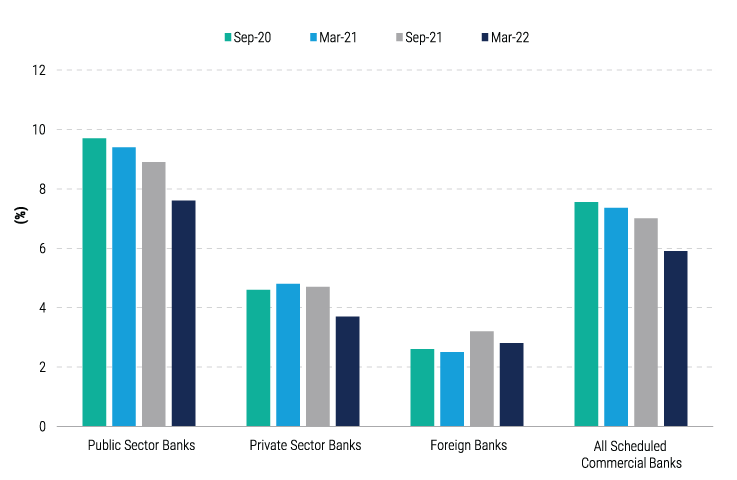
Broad economic activity remains robust, with India’s economy growing an enviable 13.5% in the April to June quarter.2 The economy is largely domestically driven, and growth is fueled by secular trends that our team has been following for some time, including a growing middle class and momentum behind digitalization, urbanization, consumption, and infrastructure. Today, India is uniquely benefiting from a multitude of factors. With a reconfiguration of supply chains for global manufactured goods, India is now establishing itself as a credible supplier. A responsive and credible monetary policy stance provides confidence that India will maintain financial and economic stability even during periods of global financial volatility. And availability of low-cost risk capital, as evidenced by several successful initial public offerings (IPOs), is helping businesses scale up rapidly.
We believe high-quality companies that can take advantage of these trends and expand their market share will continue to outperform. Market valuations remain high, which is not uncommon for India. In such a dynamic market with multiple competitors rising in each niche, we cannot overemphasize the need for careful stock selection – a thorough company-by-company assessment to uncover hidden value.
Over the next several quarters, we see opportunities in a few areas: large cap financial and auto companies that are priced at reasonable levels; companies in their IPOs that have interesting business models and attractive pricing; and companies that use global commodities, such as energy, which should benefit from falling energy prices and improving profitability. One theme we are closely tracking is digital infrastructure development in India. The approach in India toward digitization is unique compared to the rest of the world. While global digital infrastructure tends to run on platforms, India is focused on developing “population scale” digital infrastructure that favors open protocols over closed platforms.
Can India sustain this momentum? The market headwinds for India are largely known. While inflation has been above the central bank’s 6% upper target, we believe inflation remains more manageable than in other major economies and does not warrant extreme tightening. India remains vulnerable to spikes in commodity prices, which could impact its current account and fiscal positions. However, India has created adequate room to maneuver using its currency reserves to withstand shocks, as witnessed after the onset of the war in Ukraine. The central bank’s currency reserves have remained healthy but have fallen recently due to the strong dollar. As of 7 October 2022, the reserve level was the equivalent of more than eight months of imports. On the fiscal side, we are seeing a sustained increase in goods and service tax collections, which should help ease the pressure to expand the budget deficit. Moreover, borrowings are largely financed by domestic savings, which helps insulate the country from external events.
India’s Foreign Exchange Reserves Remain Healthy
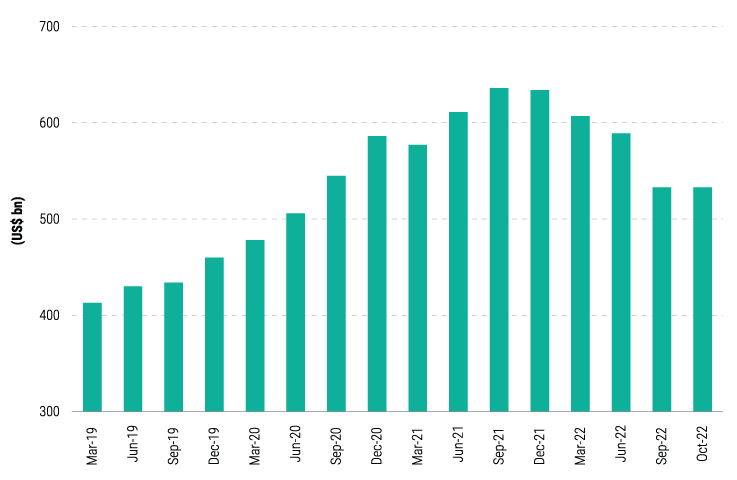
We believe India’s growing integration into global supply chains as an alternative manufacturing hub, along with rapid digitalization and a young, highly driven population of entrepreneurs, should catalyze growth opportunities over the long run.
Is China bottoming out?
In contrast to India, economic activity in China has slowed, and because of relatively low visibility into the end of Covid controls, the market has been cautious about pricing in significant expectations on policy relaxation. Should the status quo remain over the next several months, we would not see further downside in equities in China, setting up an opportunity to build up exposures in high-growth sectors. Should the opposite happen and Covid policy relaxes, the upside might be significant. We believe the Chinese A-share market offers ample opportunities for value seekers, as valuations have fallen significantly for high-quality companies that are expected to bounce back quickly once controls ease. In addition, we expect continued policy support, though calibrated to avoid creating the bubbles of the past.
Chinese Stocks Have Retreated to Pandemic-Era Lows
(As of 12 October 2022)
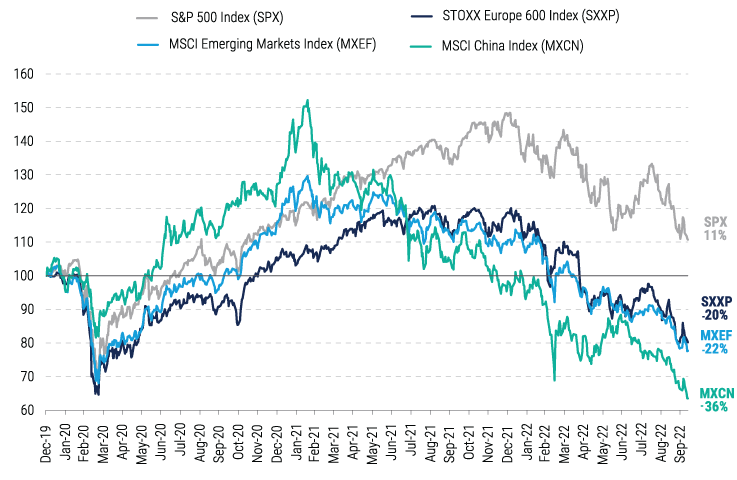
As the government continues to deleverage the property sector and redirect resources to other parts of the economy, structural opportunities are emerging in sectors such as advanced manufacturing, and other areas where China is seeking technological self-sufficiency, including consumer products, among others. With a thoughtful approach, we believe these could be areas of solid investment returns in the future.
However, geopolitical frictions need to be closely watched. Growing restrictions by the Biden administration on China’s access to advanced technologies, including cutting-edge semiconductors, have added to tensions between the two powers. With Asia the largest market for semiconductors and the big four semiconductor players based in Asia, this competition has potential spill-over effects across the region.
ASEAN also rises
The ASEAN market is the second best-performing market in Asia after India.3 With high-quality companies in the early stages of their post-pandemic recovery, many are still trading below historical averages. Companies are taking advantage of pent-up demand in the short term (for example, travel and tourism) and secular growth drivers, such as digitalization, consumption, sustainability, and urbanization, over the long term. Collectively, ASEAN economies are expected to grow 4.9% in 20234, among the fastest in the world.
Although ASEAN companies face the same inflation and rates headwinds as the rest of the world, we expect the region’s rate hikes to be less hawkish than the Fed’s. Southeast Asia is intertwined with China as a source of investment and supplies as well as a market for its products, and it could benefit from China’s reopening. However, the rise of India as an alternative global manufacturing hub poses competition for emerging Southeast Asian economies that are also positioning to attract global supply chains.
Investing through the trough
As long-term investors, we lean in on our conviction that the fundamentals of the companies in our portfolios will stand the test of time. We have seen economic slowdowns and inflationary periods before in Asia, and our decades of research and investing experience have yielded two valuable lessons. First, remaining invested through the troughs tends to yield larger rewards when the market swings back again: Today’s market challenges may turn out to be mere speed bumps in hindsight, while investments keep compounding over time. Second, while the market overall may be trending down, price dislocations and a mismatch to fundamentals may present opportunities for the long term – and selectivity is more important than ever.
For more investing insights, visit our 2023 Investment Outlook.
Disclosures
Investing involves risk, including possible loss of principal. The information presented herein is for illustrative purposes only and should not be considered reflective of any particular security, strategy, or investment product. It represents a general assessment of the markets at a specific time and is not a guarantee of future performance results or market movement. This material does not constitute investment, financial, legal, tax, or other advice; investment research or a product of any research department; an offer to sell, or the solicitation of an offer to purchase any security or interest in a fund; or a recommendation for any investment product or strategy. PineBridge Investments is not soliciting or recommending any action based on information in this document. Any opinions, projections, or forward-looking statements expressed herein are solely those of the author, may differ from the views or opinions expressed by other areas of PineBridge Investments, and are only for general informational purposes as of the date indicated. Views may be based on third-party data that has not been independently verified. PineBridge Investments does not approve of or endorse any republication of this material. You are solely responsible for deciding whether any investment product or strategy is appropriate for you based upon your investment goals, financial situation and tolerance for risk.

